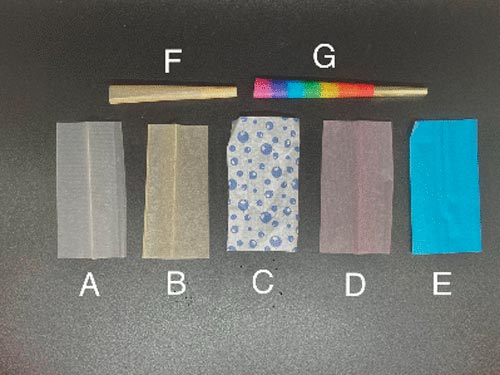A new study has revealed that rolling papers can contain heavy metals and chemical residues posing health risks, especially from chemically treated papers which have higher levels of toxic substances like benzene and toluene. The study recommends using rolling papers made from natural fibers like cannabis or bamboo to minimize exposure to harmful chemicals, along with alternatives like vaping.
Rolling Papers May Contain Traces of Heavy Metals, Study Finds


Choosing rolling papers is often seen as a minor detail, but recent scientific studies highlight its significant impact on health and the overall consumer experience.
Results from a study conducted by Lake Superior State University in Michigan reveal troubling findings about the chemical composition of rolling papers and their potential implications for cannabis consumers.
For more news like this, along with all the latest in legalization, research, and lifestyle, download our free cannabis news app.
Understanding the Risks of Rolling Papers
The study identified several concerning heavy metals in rolling papers, including copper (Cu), chromium (Cr), and vanadium (V), which can pose health risks for regular consumers.
Additionally, chemical residues from manufacturing processes introduce elements such as silver (Ag), calcium (Ca), barium (Ba), copper (Cu), and titanium (Ti) into the papers. The copper-based pigments used by many manufacturers could expose users to high concentrations of these metals.
Research Goals and Methodology
The research aimed to understand the chemical emissions produced during the burning of different types of rolling papers and to assess their potential health effects. Advanced analysis techniques, such as gas chromatography and mass spectrometry, were used to examine popular brands of papers under controlled conditions.
The study revealed variations in chemical emissions among different types of papers. Chemically treated papers showed higher concentrations of benzene and toluene, substances known for their harmful effects on respiratory and cardiovascular health. Conversely, papers made from natural fibers showed lower concentrations of these compounds, making them a safer option for health-conscious consumers.


Detailed Analysis of Different Rolling Papers
Chemically Treated Papers
Chemically treated papers, often bleached and treated with various chemicals, proved to be the most harmful. They contained much higher concentrations of substances such as benzene and toluene. Benzene is a known carcinogen, while toluene can affect the nervous system and cause other health issues. These rolling papers, while popular for their durability and aesthetics, can pose serious health risks for users.
White Paper Sheets
White paper sheets, although less harmful than chemically treated ones, still contain amounts of harmful chemicals. Although the concentrations of benzene and toluene are lower, they are still present and pose health risks. Users should be aware that, even though these are more economical options, they can still contribute to exposure to harmful substances.
Rolling Papers Made from Natural Fibers
Rolling papers made from natural fibers, such as cannabis or bamboo, have the lowest concentrations of harmful chemicals. These types of papers are often touted as more environmentally friendly and healthier alternatives to traditional papers. In the study, they showed minimal amounts of benzene and toluene, making them a much safer choice for users eager to minimize the harmful effects associated with smoking cannabis.
Recommendations for Safer Consumption Practices
Based on these findings, several recommendations are offered to consumers:
- Choose Natural Fiber Papers: Opt for papers made from natural fibers such as cannabis or bamboo to minimize exposure to harmful chemicals.
- Look for Certified Products: Seek certifications that indicate the papers are free of harmful substances.
- Inquire With Sellers: Before purchasing a pack of papers, inquire with sellers to understand their composition.
- Explore Other Consumption Methods: Consider other consumption methods, like vaporizers, for a healthier cannabis experience.
—
(Featured image by Jeff W via Unsplash)
DISCLAIMER: This article was written by a third-party contributor and does not reflect the opinion of Hemp.im, its management, staff, or its associates. Please review our disclaimer for more information.
This article may include forward-looking statements. These forward-looking statements generally are identified by the words “believe,” “project,” “estimate,” “become,” “plan,” “will,” and similar expressions. These forward-looking statements involve known and unknown risks as well as uncertainties, including those discussed in the following cautionary statements and elsewhere in this article and on this site. Although the company may believe that its expectations are based on reasonable assumptions, the actual results that the company may achieve may differ materially from any forward-looking statements, which reflect the opinions of the management of the company only as of the date hereof. Additionally, please make sure to read these important disclosures.
First published in Newsweed, a third-party contributor translated and adapted the article from the original. In case of discrepancy, the original will prevail.
Although we made reasonable efforts to provide accurate translations, some parts may be incorrect. Hemp.im assumes no responsibility for errors, omissions or ambiguities in the translations provided on this website. Any person or entity relying on translated content does so at their own risk. Hemp.im is not responsible for losses caused by such reliance on the accuracy or reliability of translated information. If you wish to report an error or inaccuracy in the translation, we encourage you to contact us.



Comments are closed for this post.